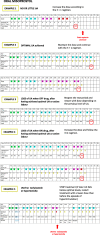Efficacy and safety of administering oral misoprostol by titration compared to vaginal misoprostol and dinoprostone for cervical ripening and induction of labour: study protocol for a randomised clinical trial
- PMID: 30621614
- PMCID: PMC6325751
- DOI: 10.1186/s12884-018-2132-3
Efficacy and safety of administering oral misoprostol by titration compared to vaginal misoprostol and dinoprostone for cervical ripening and induction of labour: study protocol for a randomised clinical trial
Abstract
Background: Among the various methods available, the administration of prostaglandins is the most effective for inducing labour in women with an unfavourable cervix. Recent studies have compared treatment with various titrated doses of oral misoprostol with vaginal misoprostol or dinoprostone, indicating that the use of an escalating dose of an oral misoprostol solution is associated with a lower rate of caesarean sections and a better safety profile. The objective of this study is to assess which of these three therapeutic options (oral or vaginal misoprostol or vaginal dinoprostone) achieves the highest rate of vaginal delivery within the first 24 h of drug administration.
Methods: An open-label randomised controlled trial will be conducted in Araba University Hospital (Spain). Women at ≥41 weeks of pregnancy requiring elective induction of labour who meet the selection criteria will be randomly allocated to one of three groups: 1) vaginal dinoprostone (delivered via a controlled-release vaginal insert containing 10 mg of dinoprostone, for up to 24 h); 2) vaginal misoprostol (25 μg of vaginal misoprostol every 4 h up to a maximum of 24 h); and 3) oral misoprostol (titrated doses of 20 to 60 μg of misoprostol following a 3 h on + 1 h off regimen up to a maximum of 24 h). Both intention-to-treat analysis and per-protocol analysis will be performed.
Discussion: The proposed study seeks to gather evidence on which of these three therapeutic options achieves the highest rate of vaginal delivery with the best safety profile, to enable obstetricians to use the most effective and safe option for their patients.
Trial registration: NCT02902653 Available at: https://clinicaltrials.gov/show/NCT02902653 (7th September 2016).
Keywords: Dinoprostone; Efficacy; Induction; Labour; Misoprostol; Safety.
Conflict of interest statement
Ethics approval and consent to participate
Women will be asked to sign the corresponding informed consent form by their gynaecologist before inclusion. This study has been approved by the Clinical Research Ethics Committee of Araba University Hospital and the Spanish Agency of Medicines and Medical Devices.
Consent for publication
Not applicable.
Competing interests
The authors declare that they have no competing interests.
Publisher’s Note
Springer Nature remains neutral with regard to jurisdictional claims in published maps and institutional affiliations.
Figures
References
-
- Sociedad Española de Ginecología y Obstetricia Protocolo SEGO. de Induccion del parto (updated July 2013) Prog Obstet Ginecol. 2015;58:54–64. doi: 10.1016/j.pog.2014.11.002. - DOI
-
- Austin SC, Sanchez-Ramos L, Adair D. Labor induction with intravaginal misoprostol compared with the dinoprostone vaginal insert: a systematic review and metaanalysis. Am J Obst Gynaecol. 2010;202:624. - PubMed
Publication types
MeSH terms
Substances
Associated data
LinkOut - more resources
Full Text Sources
Medical


